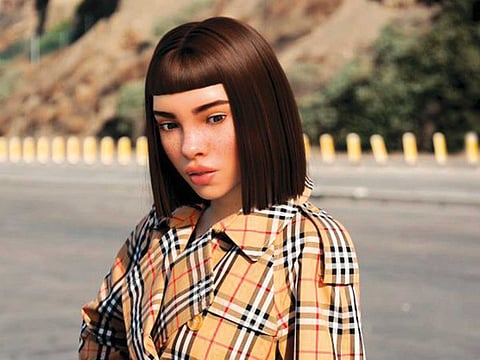The rising power of virtual influencers
Computer-generated virtual models are supplanting real flesh and blood fashionistas

Dubai: The line between real life and virtual reality has just got a little more blurred.
Computer-generated virtual models are supplanting flesh and blood fashionistas to sell the latest, hottest goods from fashion to food.
Whether you’ve noticed them on your feed yet or not, the so-called “virtual influencers” are becoming the next big thing on social media, landing major jobs and making real money in the process.
Meet Miquela, a Brazilian-American “pop star” with a follower count on Instagram of more than 1.4 million. Created as part of a digital project in 2016, Miquela also known as Lil Miquela, has become a source of fascination for many on social media and has even managed to turn heads in the fashion world.
The fictional character, who even captions her photos and pushes Prada and Chanel, among other brands, has massive influence and power over Instagram like any other real influencer.
Shudu, another fictional character, was dubbed the world’s first digital supermodel. Virtually undistinguishable from real women, Shudu is a creation by London-based photographer Cameron-James Wilson and is also helping market some of the top brands in the world.
Mimicking human influencers by uploading selfies and posing for photographs, virtual influencers are designed to portray an ideal lifestyle, with their accounts attracting people from all over the world.
Characters are created using 3D-modelling software and it often takes designers a few days to add specific features and characteristics to their avatars. Their characters are then added to real photographs in order to make them more lifelike.
A bunch of other computer-generated-imagery-created influencers are breaking on Instagram, with some even championing causes the same way as humans would.
What are marketing experts saying?
Virtual influencers are more likely to increase in the future, with more brands wanting to team up with them and tap into their fan base, said Gagan Bhalla, Managing Director at Kantar, a global insight, information and consultancy network.
What matters is not whether something exists or not, rather how creatively can a story be built around it – take Marvel or DC superheroes. They don’t exist, yet movies based on them are huge box-office grossers.

But this does not mean that their growing presence will have a major impact on human influencers making business online.
“Over the last few years, humans have become more accustomed to interacting with non-human interfaces — for example, using voice assistants like Siri or Alexa. Consumers are also aware that, in many interactions with brands, it is actually chat-bots that are responding to them. Hence, from Virtual Assistants to Virtual Brand Ambassadors is not too much of a leap, and it is likely to increase in future,” Bhalla told Gulf News.
More people are going to be drawn to virtual influencers depending on the way they are creatively presented to the audience, he said.
“What matters is not whether something exists or not, rather how creatively can a story be built around it – take the example of any Marvel or DC superhero,” said Bhalla.
“Everyone knows that they don’t really exist, yet movies based on these characters are huge box-office grossers. Therefore, the challenge in deploying Virtual Brand Ambassadors will be around how creatively they can be weaved into the brand narrative,” he said.
As consumers are considered ‘time poor’ with brands always looking at ways to compete for their attention, Bhalla said using technology to build brand narratives in a unique manner will help brands create lasting memories, which ultimately leads to higher brand equity. “Virtual influencers would allow for a far higher degree of access and personalisation [eg one could try out different outfits on the VI, through a brand website, at any time of the day or night), than a physical mannequin would ever be able to deliver.”
Will human influencers have to compete harder?
There will always be inspiring and aspirational human stories and brands will want to associate with them, said Bhalla.
But at the same time, “humans would need to be aware of their replaceability – hence, this puts pressure on them in order to uphold an appropriate image at all times.”
Bhalla predicted that the future of the virtual world is going to be even more realistic.
“We already live in an omni-channel world and over time, with advances in Artificial Intelligence, virtual reality and related technologies, the virtual world will become as realistic as the physical one... and pervade every aspect of our lives.”
Sign up for the Daily Briefing
Get the latest news and updates straight to your inbox


